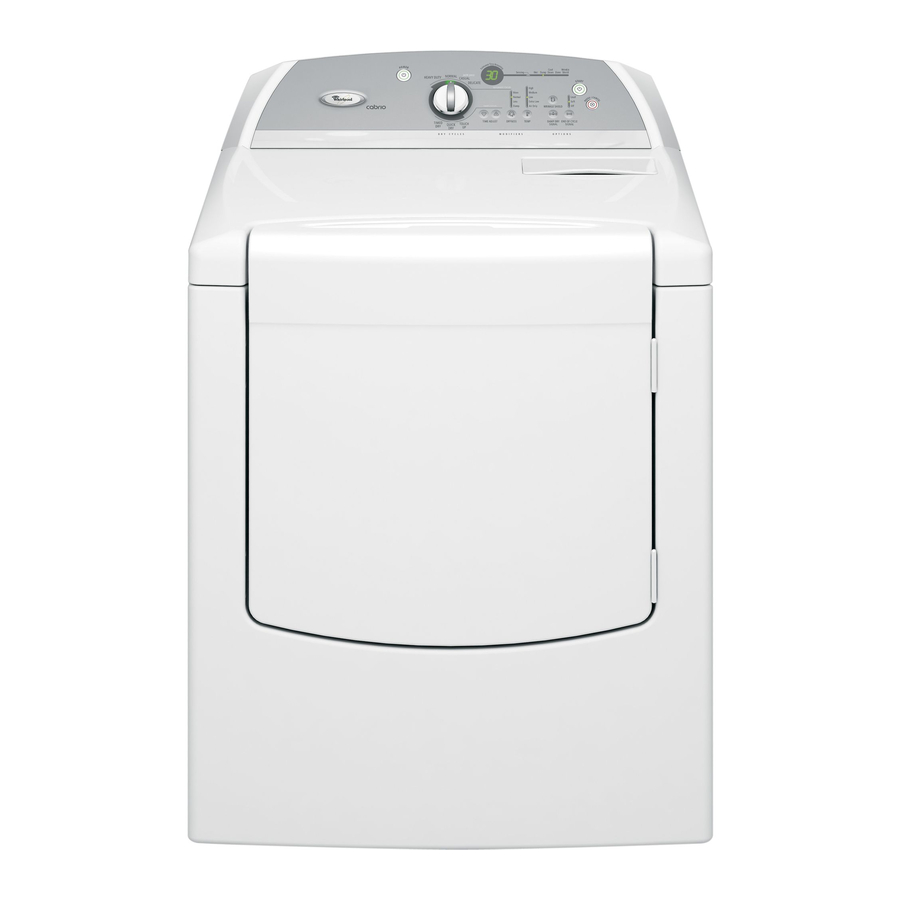- ページ 8
ドライヤー Whirlpool WGD6400SW0のPDF 技術シートをオンラインで閲覧またはダウンロードできます。Whirlpool WGD6400SW0 12 ページ。 29" gas dryer
Whirlpool WGD6400SW0 にも: パーツリスト (8 ページ), クイック・スタート・マニュアル (6 ページ)

TECH SHEET - DO NOT DISCARD
If there is an open circuit, replace the
high limit thermostat and thermal
cut-off.
Otherwise, go to step 6.
6. Perform TEST #4d. If this is OK, re-
place the machine control electronics.
Heat will not shut off:
1. Unplug dryer or disconnect power.
2. Access the machine control
electronics, remove the P14 connector,
then measure the resistance between
P14-3 (red-white wire) and P14-6
(red-white wire) at the connector. See
figure 16, page 11 for connector
location; and Accessing & Removing
the Electronic Assemblies, page 11.
If 5–15 k ohms are measured,
replace the machine control
electronics.
If the resistance is greater than
20 k ohms, replace the exhaust
thermistor.
Heat will not shut off:
1. Unplug dryer or disconnect power.
2. Access the machine control
electronics, remove the P4 connector,
then measure the resistance between
P4-3 (red wire) and P4-6 (red wire) at
the connector. See figure 16, page 11
for connector location; and Accessing
& Removing the Electronic Assemblies,
page 11.
If 5–15 k ohms are measured,
replace the machine control
electronics.
If the resistance is greater than
20 k ohms, replace the exhaust
thermistor.
TEST #4a Exhaust Thermistor
The machine control electronics monitors
the exhaust temperature using the exhaust
thermistor, and cycles the heater relay on
and off to maintain the desired
temperature.
Begin with an empty dryer and a clean lint
screen.
1. Plug in dryer or reconnect power.
2. Start the Timed Dry cycle.
F-22
3. If after 60 seconds,
flashes in the display and the dryer
shuts off, the thermistor or wire harness
is either open or shorted.
Unplug dryer or disconnect power.
Check wire connections at the
machine control electronics and
thermistor. See Accessing &
Removing the Electronic Assemblies,
page 11; and for thermistor location,
figure 10, page 7.
FOR SERVICE TECHNICIAN'S USE ONLY
If wire connections are OK, check
the exhaust thermistor resistance per
step 5.
F-22
4. If
display, the connections to the
thermistor are good. Therefore, check
the exhaust temperature value at any or
all of the temperature levels in
question, using the Timed Dry cycle,
and the following process:
Hold a glass bulb thermometer capable
of reading from 90° to 180°F (32° to
82°C) in the center of the exhaust outlet.
The correct exhaust temperatures are
as follows:
TEMPERATURE
SETTING
High
Medium
Low
Extra Low
*
The measured overshoot using the glass
bulb thermometer in the exhaust outlet
can be 30°F (17°C) higher.
5. If the exhaust temperature is not within
specified limits, or you have come here
from step 3, remove the P14 connector,
then measure the resistance between
P14-3 (red-white wire) and P14-6
(red-white wire) at the connector. See
figure 16, page 11 for connector
location; and Accessing & Removing
the Electronic Assemblies, page 11.
If the resistance is OK, check P14-3
and P14-6 to machine ground.
If resistance is greater than 0 (zero),
replace wiring harness.
NOTE: All thermistor resistance
measurements must be made while
dryer is disconnected from power.
The following table gives temperatures
and ranges for the associated
thermistor resistance values.
EXHAUST THERMISTOR RESISTANCE
TEMP.
°F (°C)
50° (10°)
60° (16°)
F-23
or
70° (21°)
If the thermistor resistance does not
agree with table, replace the exhaust
thermistor.
If the thermistor resistance checks
agree with the measurements in the
table, replace the machine control
electronics.
F-23
or
does not flash in the
EXHAUST TEMPERATURES
HEAT TURNS OFF*
HEAT TURNS ON
°F (°C)
°F (°C)
155°±5° (68°±3°)
10°–15° (6°–8°)
140°±5° (60°±3°)
below the
heat turn off
125°±5° (52°±3°)
temperature
105°±5° (41°±3°)
RES.
TEMP.
RES.
k Ω
k Ω
°F (°C)
19.0–22.0
80° (27°)
8.5–10.5
14.8–16.8
90° (32°)
6.8–8.8
11.5–13.5 100° (38°)
5.0–7.0
TEST #4b Thermal Fuse
The thermal fuse is wired in series with the
dryer drive motor.
1. Unplug dryer or disconnect power.
2. Access the thermal fuse by first
removing the back panel. See
Removing the Back Panel, page 11;
and for thermal fuse location see
figure 10, page 7.
3. Using an ohmmeter, check the
continuity across the thermal fuse.
If the ohmmeter indicates an open
circuit, replace the failed thermal
fuse.
TEST #4c Thermal Cut-Off
If the dryer does not produce heat, check
the status of the thermal cut-off.
1. Unplug dryer or disconnect power.
2. Access the thermal cut-off by first
removing the back panel. See
Removing the Back Panel, page 11.
3. Using an ohmmeter, check the
continuity across the thermal cut-off.
See figure 10, page 7, for location.
If the ohmmeter indicates an open
circuit, replace the failed thermal
cut-off and high limit thermostat. In
addition, check for blocked or
improper exhaust system.
TEST #4d Gas Valve
1. Unplug dryer or disconnect power.
2. Access the gas valve by removing the
front panel and drum assembly. See
Removing the Front Panel/Drum
Assembly, page 10.
3. Use an ohmmeter to determine if a
gas valve coil has failed. Remove
harness plugs. Measure resistance
across terminals. Readings should
match those shown in the following
chart. If not, replace coil.
Terminals Resistance
1365 ± 25
1 to 2
560 ± 25
1 to 3
1
1220 ± 50
4 to 5
2
IMPORTANT:
Be sure all harness
wires are looped back
through the strain
relief after checking or replacing coils.
PART NO. W10054160
PAGE 8
3
4 5
